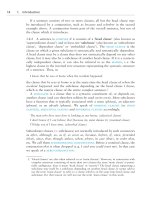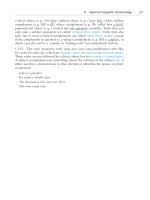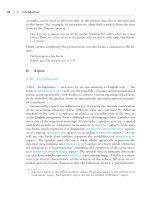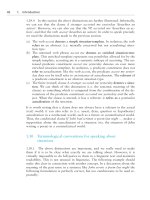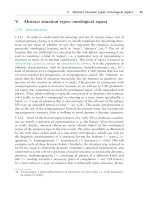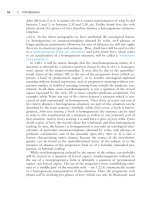The grammar of the english verb phrase part 64 pdf
Bạn đang xem bản rút gọn của tài liệu. Xem và tải ngay bản đầy đủ của tài liệu tại đây (62.88 KB, 7 trang )
434 8. Temporal domains and relative tenses: theoretical foundations
VI. Summary of chapter 8
8.42 Terminology
8.42.1 We started out this chapter with a review of some terms and concepts
that had already been introduced in previous chapters, especially in chapter 2:
time of the full situation vs situation time (ϭ time of the predicated situation),
only the latter of which is located in time by the tense form used; homogeneous
(ϭ L-nonbounded) situations (for which every subpart is representative of the
whole situation) vs nonhomogeneous (ϭ L-bounded) situations (for which the
situation as a whole is different from any subpart of it); several types of orien-
tation time, which is a time (possibly a situation time) with respect to which
another orientation time (usually a situation time) is represented by a tense
form as either T-simultaneous (coinciding), T-anterior or T-posterior; similar
temporal relations not expressed by tense forms (referred to as W-relations);
the use of absolute tenses to locate a situation time in any of the four absolute
zones (i. e. portions of the time line defined relative to t
0
) Ϫ either in the past
zone (coinciding with the past time-sphere) or in any of the three present time-
sphere zones (the pre-present, the present or the post-present zone); the use of
relative tenses to relate a situation to (i. e. make it temporally subordinated to
or T-bound by) an orientation time other than t
0
and thereby expand a tempo-
ral domain set up by an absolute tense form.
8.42.2 The one orientation time that is not T-bound by any other in a domain
is the central orientation time. The absolute zone in which it is located deter-
mines the overall temporal nature of the domain. Thus, in (He said) he would
do it tomorrow, the situation time referred to by would do forms part of a
past domain, established by the past tense form in He said (or, in the absence
of such a past tense head clause, by an unspecified central orientation time
located in the past zone). There is a certain correlation between temporal sub-
ordination and syntactic subordination: for one, the use of a relative tense to
express T-simultaneity is excluded in a syntactically independent clause; for
another, the use of an absolute tense is excluded in some types of subclauses.
If a situation time is represented as T-simultaneous with another situation
time, the exact duration and temporal location of the T-bound situation time
(ϭ time of the predicated situation) is unidirectionally determined by the bind-
ing situation time. Thus, in I noticed at once that Jim was ill, the situation
time expressed by [Jim] was [ill] strictly coincides with the time of me noticing
it, which is merely a point (rather than a durative interval) in the past time-
sphere. Of course, the full situation time of Jim being ill will be extralinguisti-
cally interpreted as much longer than, and as properly including, the time of
me noticing it and may possibly even include t
0
, which shows that W-simulta-
neity is a concept quite different from T-simultaneity.
VI. Summary of chapter 8 435
Sometimes the speaker does not use a relative tense form (expanding an
already established domain) but instead uses an absolute tense form, causing a
shift of domain, either within the same time-zone or from one time-zone to
another. When the shift of domain is within the same zone, the hearer may
draw clues as to the temporal ordering of the situation times from such sources
as the presence of temporal adverbials, the order of appearance of the clauses,
the linguistic and extralinguistic context, his pragmatic knowledge of the world
or, as will be summarized below in 8.45, the (non)boundedness of the situations
referred to.
We speak of a shift of temporal perspective when a situation intended to be
interpreted as located in one absolute zone is referred to by a tense form that
is characteristic of another zone, as when the present tense is used with refer-
ence to the post-present zone (e. g. They’re leaving soon), to the past zone
(e. g. Napoleon strikes back) or to the pre-present zone (e. g. I hear John has
been promoted).
8.43 Evidence for the existence of two past tenses
There are two tenses in English that make use of the same past tense morphol-
ogy but which differ in meaning: the absolute past tense means ‘The situation
time is located in the past time-sphere’, whereas the relative past tense means
‘The situation time is T-simultaneous with an orientation time in a past domain
(or in a past or pseudo-past subdomain)’. We have adduced ten arguments for
this claim. These are briefly summarized here. Needless to say, the reader can
only properly evaluate their validity by examining their full discussion in part
IV of this chapter.
8.43.1 The view that the sentence John felt unhappy when he was alone con-
tains both an absolute past tense form (felt) and a relative one (was) is corrobo-
rated by the fact that we clearly distinguish an absolute tense form (will be)
and a form indicating T-simultaneity (is) in its post-present counterpart: John
will be unhappy when he {is / *will be} alone.
8.43.2 In a sentence like Mary told me on the phone last night that at the
dinner party tomorrow she would suddenly say that she felt sick, the past tense
form felt refers to a situation which lies in the post-present. This kind of sen-
tence demonstrates the inadequacy of the assumption that there is only one
past tense in English, which is used to locate a situation time prior to t
0
.By
contrast, this use of the past tense is naturally explained in a theory which
assumes the existence of a relative past tense (next to an absolute one), which
expresses T-simultaneity in a past domain, irrespective of the W-location of the
binding time relative to t
0
.
436 8. Temporal domains and relative tenses: theoretical foundations
8.43.3 Distinguishing between absolute and relative past tenses explains why
some past tense forms are ‘backshifted’inpast represented speech while others
are not. Consider:
“I was in Greece at the time.” J Jane said she had been in Greece at the time. (The
original absolute past tense form was is ‘backshifted’.)
“Millie complained that she wasn’t feeling well.” J John told us that Millie had
complained that she {wasn’t /#hadn’t been} feeling well. (The original relative past
tense form wasn’t feeling cannot be ‘backshifted’ without triggering an unwanted
anteriority reading.)
8.43.4 The claim that there are two types of past tense in English, an absolute
and a relative one, is supported by the fact that an absolute past tense form
is compatible with an unanchored punctual time-specifying adverbial (i. e. an
adverbial of the type at X o’clock), whereas a relative past tense form is not:
I was still thirsty at five o’clock. (was is an absolute past tense form)
Jim whispered that he was still thirsty. (On the unmarked interpretation, was is a
relative past tense form expressing T-simultaneity.)
Jim whispered that he was still thirsty at five o’clock. (Was cannot be interpreted as
expressing T-simultaneity. It is an absolute tense form, locating its situation time at
a time which is interpreted as preceding the time of the whispering.)
8.43.5 In a sentence referring to a past habit, an absolute past tense form can
be replaced by used to (which expresses T-anteriority to some orientation time),
whereas a relative past tense form cannot:
As a child I {was / used to be} afraid of spiders. (Was is an absolute past tense form
expressing T-anteriority to t
0
.)
I saw with my own eyes that he {was /*used to be} afraid of spiders. (Was is
a relative past tense form expressing T-simultaneity with the past situation time
of saw.)
8.43.6 The existence of a relative past tense (expressing T-simultaneity with
an orientation time in a past domain) accounts for the obligatory use of the
past tense (rather than the conditional tense) in the adverbial time clause of a
sentence like the following:
John decided that he would wait until his wife {arrived /*would arrive}.
If we assume that the meaning of until includes an implicit orientation time Ϫ
until means ‘until the time that’ Ϫ the use of the past tense is explained natu-
rally: it represents the situation time of John’s wife’s arrival as T-simultaneous
with the implicit orientation time.
8.43.7 John said that Mary was ill allows a reading in which Mary was ill at
the time of John’s utterance and one in which Mary was ill at some time
VI. Summary of chapter 8 437
preceding John’s utterance. Our claim that these two interpretations are a
matter of ambiguity (tense structure) and not vagueness (W-interpretation) is
confirmed by Lakoff’s well-known test to distinguish between ambiguity and
vagueness.
8.43.8 In John said that he was writing a book, the use of the progressive
form is compulsory if we want to express the idea that at the time of his
utterance John was engaged in the (telic) situation of writing a book. In the
same way as we cannot say *I write a book, we cannot say *John said that he
wrote a book (on the relevant interpretation). This can only be explained if we
posit the existence of a relative past tense meaning ‘The situation time is T-
simultaneous (ϭ strictly coinciding) with an orientation time in a past domain’.
Since the time of saying (which functions as T-binding time) is (nearly) punc-
tual, we need to represent the much longer situation of writing a book as
homogeneous (by using the progressive), so that the full situation can be con-
ceived of as consisting of representative subparts, one of which has the same
restricted duration and temporal location as John’s utterance and can therefore
function as the time of the predicated situation.
8.43.9 In a theory adopting the existence of a relative past tense meaning ‘the
situation time is T-simultaneous (ϭ strictly coinciding) with a past orientation
time’, we can nicely explain why the subclause in a sentence like John knew
that I wrote a book cannot be interpreted in terms of T-simultaneity (i. e. as
using a relative tense). If wrote were a relative past tense form, the bounded
situation of my writing a book would have to derive its temporal specification
from the nonbounded situation time of John knowing it, which is pragmati-
cally impossible.
8.43.10 English and Dutch are cognate languages. In Dutch, the absolute and
the relative past tenses are clearly distinct, since only an absolute preterite form
can be replaced by the present perfect. Thus, to use an English gloss, we find
Dutch sentences like Yesterday he {admitted / has admitted} that his father
{was / *has been} dead. This difference in substitutability Ϫ the absolute past
tense in the head clause can be replaced by the present perfect, while this
substitutability does not exist for the relative past tense in the subclause Ϫ
shows that Dutch has two past tenses, an absolute one and a relative one. This
suggests that it is quite possible that in English, too, there are two distinct
past tenses.
8.44 Further theoretical conclusions
From the ten arguments summarized above, we have drawn seven theoretical
conclusions, which are summarized here very succinctly. Firstly, the existence
of two distinct meanings (an absolute and a relative temporal meaning) corre-
438 8. Temporal domains and relative tenses: theoretical foundations
sponding with a single form (the past tense) is not a case of one past tense
being ambiguous but of two different tenses having the same formal expression
(i. e. being homophonous). Secondly, what is ‘past’ about the meaning of the
past tense morpheme used in both absolute and relative preterite forms is the
idea that the situation time belongs to a past domain.Thirdly, the past tense
morpheme in all the relative past time-sphere tenses (the relative past tense,
the past perfect and the conditional tense and the conditional perfect) conveys
the meaning ‘The binding orientation time forms part of a past domain’.
Fourthly, there is a parallelism between the system of tenses with a past tense
morpheme and the system of tenses with a present tense morpheme, in that all
the tenses belonging to the former system express that the situation time is
located in a domain lying in the past time-sphere and all the tenses belonging
to the latter system express that the situation time is located in a domain
lying in the present time-sphere domain, and in that the tense expressing T-
simultaneity is the unmarked one of all the tenses in either system. Fifthly,
although each tense has a single invariant temporal meaning, it is possible to
encounter metaphorical extensions of this meaning (e. g. in the case of a shift
of temporal perspective). Sixthly, the meaning of the past tense morpheme
allows for the possibility that a conditional tense form is W-interpreted as
referring to a situation that is posterior to t
0
. This proves that reference to
temporal domains (established by absolute tenses and expanded by relative
ones) is central to any viable tense theory. Seventhly, if there are two homopho-
nous past tenses, they should differ in their distribution Ϫ something which
we will show to be true in chapter 9.
8.45 The role of (non)boundedness in the unmarked
temporal interpretation of situations
When there is a shift of domain within the same absolute zone, the temporal
order of the situations (if relevant at all) may be recovered from a variety of
clues. One clue that was discussed in some detail in part V is the bounded or
nonbounded nature of the situations as represented by the various (unembed-
ded) clausesusing an absolute tense form. This has led to the formulation of
the Principle of Unmarked Temporal Interpretation, summarized as follows:
In the absence of any adverbial, contextual or pragmatic indication of temporal or-
der,
(a) a sequence of bounded clauses will tend to be interpreted in terms of iconic
sequencing: situations follow each other in the order in which they are reported
(e. g. John went to the door and knocked three times. The door opened slowly);
(b) a sequence of nonbounded clauses will tend to be interpreted as W-simultaneous
to each other (e. g. John stood by the window. Mary was in the kitchen);
VI. Summary of chapter 8 439
(c) a sequence of two clauses in which one clause is bounded whereas the other is
not will tend to be interpreted in terms of inclusion: the bounded situation is
included in the nonbounded one (e. g. John went out of the room. He was feeling
very tired).



